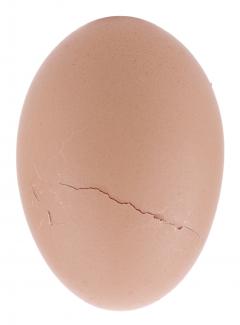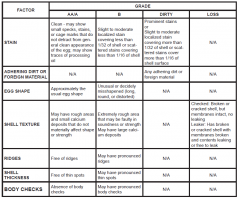Market Eggs - Exterior egg grading
Evaluating eggs for exterior quality reduces the number of eggs with defects that detract from the eggs’ appearance or that would have a low probability of surviving the rigors of handling in normal market channels. In other words, we want the consumer to have clean, unbroken eggs with practically normal shape and texture. Contestants should not be too harsh in assigning a grade to eggs that may have minor defects. This is especially important when judges have gained experience in evaluating eggs with various degrees of abnormalities. Shell color does not affect the quality of the egg and is not a factor in the U.S. standards and grades. Eggs are usually sorted for color and sold as either “whites” or “browns.” For the 4-H poultry judging contest exterior egg classes, all chicken eggshell colors can be used. In a contest, excessively speckled brown eggs should not be used.
Table 1 summarizes the descriptive terminology used in the USDA Egg Grading Manual to help determine an egg’s grade by exterior quality. Grades AA and A have identical standards for exterior quality. For 4-H poultry judging contests, therefore, eggs will be assigned the grades of A, B, Dirty, or Loss. The factors that affect exterior quality are discussed below. Eggs graded for exterior quality cannot be handled during the contest. Since contestants are not able to handle the eggs, the eggs are placed sideways on egg cartons and contestants must assume the unseen side is free of any stains, adhering material, cracks, or defects.
Table 1. USDA Standards for grading market eggs (click on image to enlarge).
CLEANLINESS
Grade A eggs must be clean (see Figure 1). Grade A eggs may show small specks, stains, or cage marks that do not detract from the general clean appearance of the egg. Grade A eggs can also show traces of processing oil (used to preserve freshness). The processing oil may create a shiny or opaque appearance.
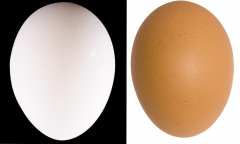
'Cage marks' is the term used to refer to marks or translucent lines on the shell when eggs are collected (see Figure 2). Marks or lines are due to rusty or dirty wires in the cage floor or egg roll-out trays. Translucent lines result when the shell fails to dry out quickly after laying. Grade A eggs may show small cage marks that do not detract from the general appearance of the egg. Darker cage marks that do detract from the appearance of the egg would be Grade B. Eggs with large cage marks having a 3-dimensional appearance would be considered dirty eggs.
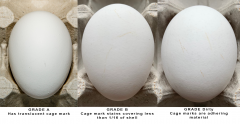
Any eggs with slight to moderate stains can be Grade B or dirty depending on the number and size of the stains. If there is a single stain, it is referred to as a localized stain. A Grade B egg can have a slight to moderate stain that covers less than 1/32 of the entire shell (see Figure 3 for relative sizes). If there are two or more stains, these are referred to as scattered stains. The amount of stain is added up, and if the total covers less than 1/16 of the entire shell, it is a Grade B egg. Any eggs with slight to moderate stains covering an area larger than these allowed amounts are classified as dirty eggs. All prominent stains are considered dirty eggs. See Figure 4 for eggs with various levels of stain(s) on the eggshells.
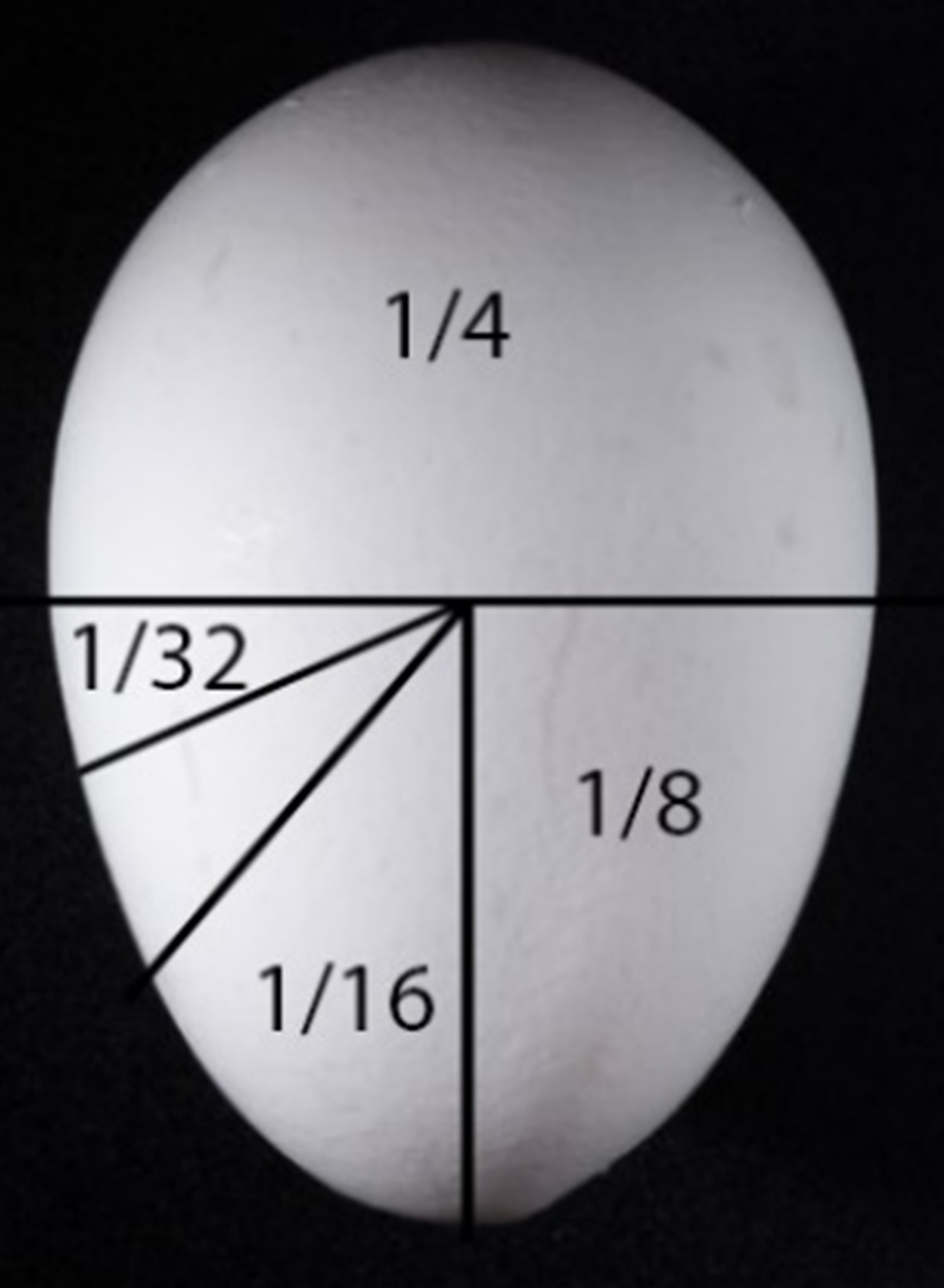
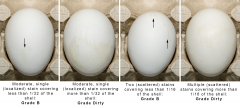
Eggs with adhering material (3-dimensional) larger than a speck will be classified as dirty. Small specks of dust, eyelashes, pencil marks, or lint that may have settled out of the air should not be considered. An attached feather, however, would be considered adhering material. See Figure 5 for examples of eggs with adhering material.
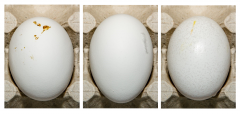
SHAPE
A considerable range of egg shapes may be considered “approximately the usual shape” or Grade A (see Figure 1). Eggs that are spherical (round) or too long to fit in the egg carton should be graded B quality (see Figure 6). B quality grades include eggs that are clearly misshapen or that have definite flat areas.
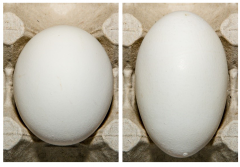
TEXTURE
Eggs with faulty texture are much weaker in shell strength and may be broken during distribution. Occasionally, calcium deposits will appear on eggshells. Unlike stains, the calcium deposits are not added together. If the calcium deposits on an egg are less than 1/8 inch in diameter, the egg is Grade A. There is no standard for the number of calcium deposits allowed on an egg, which means that an egg with small calcium deposits over the entire shall be classified as Grade A, as long as all the calcium deposits are each less than 1/8 inch in diameter (see Figure 7).

If any of the calcium deposits are larger than 1/8th inch in diameter, the egg is classified as Grade B. A good rule of thumb is that if you were to run your fingernail across a calcium deposit and a good size hole would be created if it came off, then the egg would be classified as Grade B.
Grade A eggs may have slight rough areas to the shell that do not materially affect egg shape or the strength of the shell. Eggs with extremely rough areas that may be faulty in soundness or strength are Grade B (see Figure 8).

RIDGES
Ridges can result in weakened shells. Eggs with large ridges are Grade B (see Figure 9).
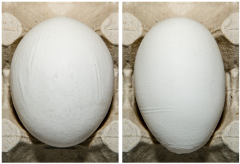
SHELL THICKNESS
The shell should appear thick enough to withstand reasonable handling without breaking. Grade A eggs must have thick shells with no thin spots. Thin shells or thin spots would place an egg in Grade B. In all cases, the shell must not be broken. The thin spots can be large or small as in Figure 10. Small thin spots are referred to as ‘windows.’ To be considered a window, the thin spot must be three-dimensional. It is important that cage marks (see Figure 2) not be confused for windows.
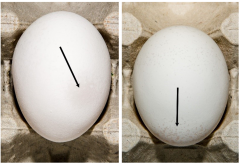
BODY CHECKS
Body checks can cause weakened shells. This is a condition in which the eggshell looks like it is cracked but the shell is intact. Body check occurs during shell formation when the shell is cracked and then partially calcified before being laid. An egg with body check is classified as Grade B. When candled (see Figure 11), the shell can be seen to be intact, but weak. This should not be confused with a 'Check egg' which is graded as a Loss egg.
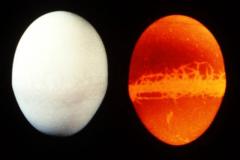
LOSS EGGS
An egg that has a broken shell or a crack in the shell, but its shell membranes are intact, and egg contents do not leak, is considered checked and should be classified as a Loss. An egg that has a crack or breaks in the shell and the egg contents are exuding or free to exude through the shell, are considered as leakers and should be classified as a Loss. The 4-H poultry judging contest does not use leakers.
